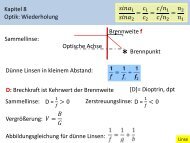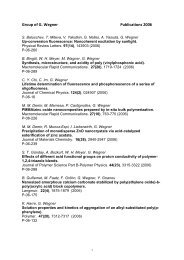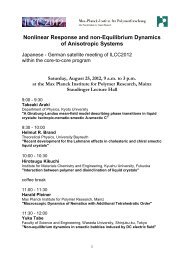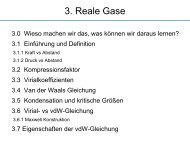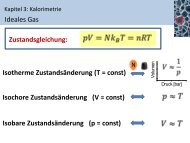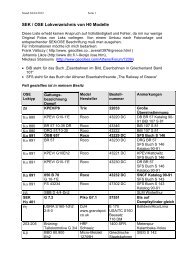Cyclic Voltammetry
Cyclic Voltammetry
Cyclic Voltammetry
Create successful ePaper yourself
Turn your PDF publications into a flip-book with our unique Google optimized e-Paper software.
4 CHAPTER 1. CYCLIC VOLTAMMETRY<br />
1.2 Electrode Reactions<br />
A typical electrode reaction involves the transfer of charge between an electrode and a species in solution.<br />
The electrode reaction usually referred to as electrolysis, typically involves a series of steps:<br />
1. Reactant (O) moves to the interface: this is termed mass transport<br />
2. Electron transfer can then occur via quantum mechanical tunnelling between the electrode and<br />
reactant close to the electrode (typical tunnelling distances are less than 2 nm)<br />
3. The product (R) moves away from the electrode to allow fresh reactant to the surface<br />
The ‘simplest’ example of an electrode reaction is a single electron transfer reaction, e.g. Fe 3+ + e − =<br />
Fe 2+ . Several examples are shown in Fig. 1.1<br />
Figure 1.1: Simple electrode reactions: (left) A single electron transfer reaction. Here the reactant<br />
Fe 3+ moves to the interface where it undergoes a one electron reduction to form Fe 2+ . The electron is<br />
supplied via the electrode which is part of a more elaborate electrical circuit. For every Fe 3+ reduced<br />
a single electron must flow. By keeping track of the number of electrons flowing (ie the current) it is<br />
possible to say exactly how many Fe 3+ molecules have been reduced. (middle) Copper deposition at a<br />
Cu electrode. In this case the electrode reaction results in the fomation of a thin film on the orginal<br />
surface. It is possible to build up multiple layers of thin metal films simply by passing current through<br />
appropriate reactant solutions. (right) Electron transfer followed by chemical reaction. In this case an<br />
organic molecule is reduced at the electrode forming the radical anion. This species however is unstable<br />
and undergoes further electrode and chemical reactions.<br />
1.3 Electron Transfer and Energy levels<br />
The key to driving an electrode reaction is the application of a voltage. If we consider the units of volts<br />
V = Joule/Coulomb (1.1)<br />
we can see that a volt is simply the energy required to move charge. Application of a voltage to an<br />
electrode therefore supplies electrical energy. Since electrons possess charge an applied voltage can alter<br />
the ’energy’ of the electrons within a metal electrode. The behaviour of electrons in a metal can be<br />
partly understood by considering the Fermi-level. Metals are comprised of closely packed atoms which<br />
have strong overlap between one another. A piece of metal therefore does not possess individual well<br />
defined electron energy levels that would be found in a single atom of the same material. Instead a<br />
continum of levels are created with the available electrons filling the states from the bottom upwards.<br />
The Fermi-level corresponds to the energy at which the ’top’ electrons sit.



